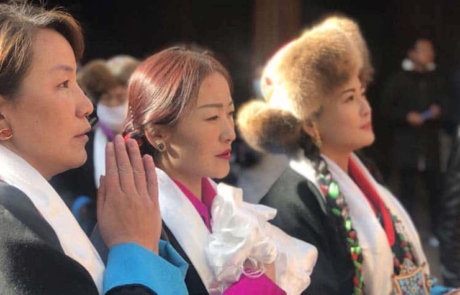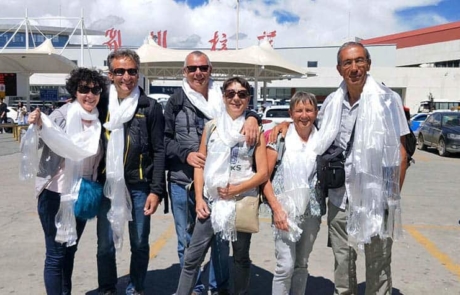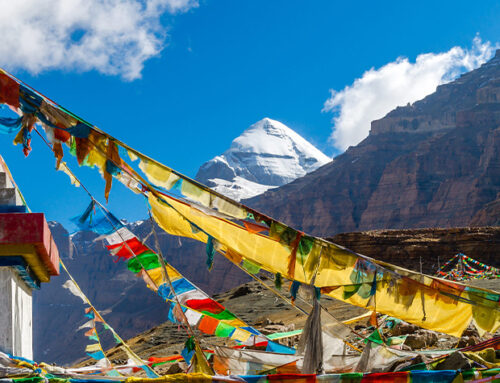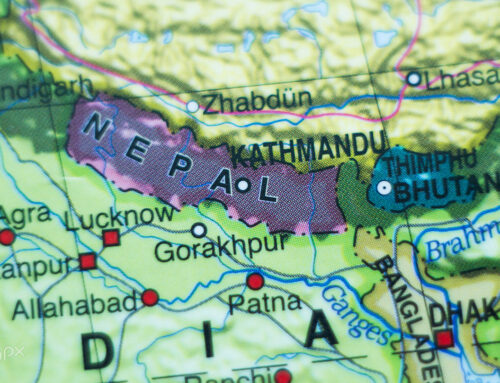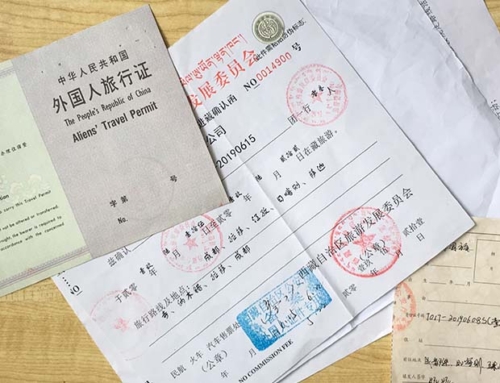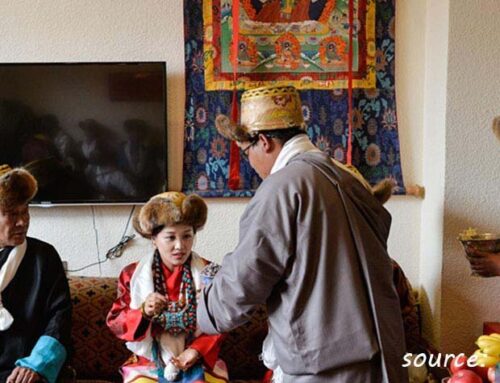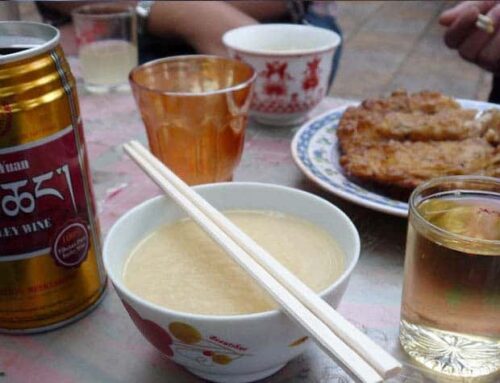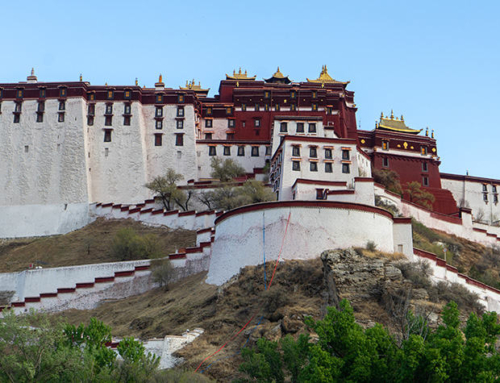Khata ཁ་བཏགས། Tibetan Ceremonial Scarf is one of the essential pieces of cloth in Tibetan culture. The term Khata is an informal and formal term for the traditional Tibetan scarf is call Jel-Dhar. When you travel to Tibet, Your Tibetan Guide will offer Khata on your arrival. We think it would be important for us to write about this culture.
The most common color of the Khata is white to signify the purity of the intention of the offerer, with no negative thoughts or motives behind it. There are other colors use in Khata like Blue, red, green and Yellow. It looks like a long scarf, and it has auspicious signs and Mantras inscribed on it.
It is an essential part of our life and would use for all the occasion from birth to marriage and even death. It is a sign of love and respect for others. The offering of Khata is one of the most well-known customs in Tibetan culture. When you arrive in Tibet for your Tibet travel, you will be offered the Khata on arrival or departure from Lhasa or Tibet.
The size and fabric quality of Khata can be different for the choice of presenter. The most elegant one is made of pure silks, and the most simple one is made of simple cotton. It is not a matter of the quality of the cloth, but then it is the matter of sincerity of the offerer.
History of Khata
There are many different schools of thought about the origin of the Khata. The most popular one is from the Han Dynasty. During the Han dynasty, they send a diplomatic mission to the western region. The diplomats pass through Tibet and present silk roll to the leader of the local chief. Those times silks were ceremonial offering, and it symbolizes pure friendship. This etiquette of showing friendliness and wishes was the practice in the local tribe. Later the new custom is passed to the central plans and Yarlung river valley.
Another school believes the custom of Khata is Tibetans own development. During the time of the early Tibetan Tubo dynasty especially during the time of King Songtsen Gampo, King would present honouring the gift of the skin of a prized Animal to anyone for a good job. But after the arrival of Buddhism in Tibet in the 8th century. The Sages like Guru Rinpoche and Shantarakshita discourage giving animal skins, as it required the killing of animals for their skin. In India, there is a tradition of giving offerings of sets of new cloth to the master. The tradition of presenting animal skin is replaced with expensive silk brocade from China under the influence of Indian culture or master. Then it gradually changes into the current Khata culture.
According to the third school of thought. This culture prevalent in the pre-Buddhist nomadic communities of Tibet. They said the culture of Khata came from Kanak culture. In the Kanak Culture, we would put a pinch of tsampa on the shoulder of the guest that visit for work or visit to signify the host sincerely of their wishes of Welcome, respect, and farewell. Tsampa is put on the right shoulder for the men and left on the women. They also put the beautiful display of symbols and greeting on the floor to welcome high lama and officials. This tradition gradually became the Khata culture,
How to offer Khata
Offering Khata though is a very simple gesture, but in our tradition, it has its own significance and protocol governing this tradition.
Here are some protocols/etiquette in offering Khata
- Khata must be clean and wrinkle free which is why we used the new one on all the occasions nowadays. But in old time we will take extra care to make sure it is clean and wrinkle-free.
- Khata must be properly folded. When folding, it must be first fold in half width-wise. It represents the interdependence of our existence. After this fold, we will fold the Khata in fan effect and roll up to end the folding. When presenting the Khata, we must open it infant of the receiver. While holding khata to offer, you must hold it with your open palm. The open edge should face the person you are giving, and the folded end should be towards you. This represents your pure open heart, with no negative thoughts or motives in the offering.
- Bow before the receiver.
- If the receiver is higher than you, offer it on their hand, and if the receiver is of your equal or lower level, you can place khata around their neck.
Purpose of offering Khata
Respect/ Gratitude.
For high lamas, teacher dignitaries and elders. When you give them Khata, it should be presented with folded hands places near your forehead, and bow before them in Humble. You will never put khata over the neck of someone higher, and older than you. If the receiver is the elder and more senior than you, you will most like to get the khata back to you as a blessing. Special from the high lama, the returned khata is considered a blessing and will always be kept with them. We also have the custom of putting khatas over the statues, Thangka painting, portrait of reincarnated Masters and over the altar. These are to show our devotion and aspiration from them. We also put the Khata on the prayer flags before hanging them. It is a sign of purity and sincerity of our prayer, and it is also an offering to gods for swift accomplishments of prayers and wishes.
We also use Khata when we visit some one’s home after the death of a near one. Khata is laid over the body, here represent our prayers for deceased swift rebirth and free from suffering in after-death stages.
Affections and celebration.
Khata can also be used for special events like birthday, New year ( Losar), farewell, marriage, welcome, honor celebration and any other day to day event in one’s life journey. During these occasions, we will offer khatas.
Colors and Patterns
The Meaning of White Khata: The most common color for a Khata is white. White symbolizes purity, sincerity, kindness, and justice. Ivory Khata is also prevalent. There are variations, including Khata in colors representing the five elements, like blue for the sky, white for air, red for fire, green for water, and yellow for earth.
Special Types of Khata: There are different types of Khata, including the ashi Khata, which is simpler and has a single layer of tassels. On the other hand, Nangzö Khata is longer, wider, and has a double layer of tassels, often reserved for significant occasions like the enthronement of high lamas or diplomatic events.
Symbols on Khata
The Eight Auspicious Symbols of Buddhism: Many Khata feature mantras and the eight auspicious symbols of Buddhism woven into the fabric. These symbols represent offerings made to the Buddha when he attained enlightenment. Each symbol holds a profound meaning.
- The Precious Parasol: Represents protection from suffering.
- The Two Golden Fish: Symbolize living beings practicing the dharma in fearlessness.
- The Vase of Great Treasures: Symbolizes health, long life, wisdom, and prosperity.
- The Lotus Flower: Signifies purity rising above attachment and desire.
- The White Conch Shell: Represents the profound sound of the dharma awakening beings.
- The Eternal Knot: Signifies cause and effect and the union of compassion and wisdom.
- The Victory Banner: Represents the Buddha’s triumph over hindrances.
- The Eight-Spoked Dharma Wheel: Represents the path of virtuous actions leading to enlightenment.
Conclusion
In conclusion, Khata is not just a piece of cloth; it is a bridge connecting the material and spiritual realms. It signifies respect, purity, and well-wishing in Tibetan culture, serving as a symbol of goodwill, protection, and blessings. Understanding the deep meanings behind its colors, patterns, and symbols brings us closer to the rich tapestry of Tibetan traditions.
FAQs
What is the significance of a white Khata?
White Khata, holds a profound symbolism that goes far beyond its pristine appearance. It serves as a powerful embodiment of values and emotions, making it an essential part of various rituals and expressions of goodwill.
Purity: White, often associated with cleanliness and purity, represents the untarnished nature of the human heart. The white Khata is a symbol of the pure intentions and sincerity with which it is offered. In a world where purity of heart is a virtue cherished by many, the white Khata signifies a genuine and untainted connection between the giver and receiver.
Kindness: Kindness is one of the fundamental virtues that the white Khata embodies. It is offered as a gesture of kindness and compassion, signifying the goodwill and warm-heartedness of the giver. When presented with a white Khata, one is not just extending a piece of fabric but expressing their genuine care and affection.
Sincerity: The color white, often associated with truth and honesty, is a reflection of the sincere emotions that accompany the presentation of a Khata. It conveys authenticity, openness, and a heartfelt desire to connect with another person. Sincerity is a core value, and the white Khata encapsulates it beautifully.
Justice: In some contexts, white symbolizes justice and fairness. When a white Khata is offered, it can be seen as a wish for justice, fairness, and righteousness in the life of the recipient. It serves as a reminder that the actions and decisions taken should be just and guided by ethical principles.
Goodwill and Respect: Ultimately, the white Khata is a vehicle for expressing goodwill and respect. It’s a symbol of the giver’s best intentions and a gesture of respect for the receiver. Whether presented during celebrations, ceremonies, or everyday interactions, it encapsulates the hope for the well-being and happiness of the recipient.
In essence, the significance of a white Khata is deeply intertwined with the values of purity, kindness, sincerity, and justice. It is a tangible representation of the goodwill and respect one person extends to another, making it a cherished and meaningful tradition in Tibetan culture.
When is a Khata typically offered?
Khata is a versatile symbol of respect, goodwill, and tradition, deeply woven into the cultural fabric of Tibet and neighboring regions. It finds its place in numerous life events and ceremonies, playing a pivotal role in conveying emotions, blessings, and best wishes. Here are some of the common occasions when Khata is typically offered:
Births: The arrival of a new life is a joyous occasion in many cultures, and in Tibetan culture, it’s no different. Khata is offered to celebrate the birth of a child, symbolizing the hope for a pure and blessed life. It is a gesture of welcome into the world and the community.
Weddings: Weddings are a momentous chapter in a person’s life, and Khata is presented to the bride and groom as a token of best wishes and blessings for a harmonious and prosperous married life. It signifies the purity of love and the sincerity of the commitment made in matrimony.
Funerals: In times of grief and loss, Khata takes on a different meaning. It is offered as a gesture of sympathy and respect to the deceased and their family. White Khata, in this context, symbolizes the hope for the departed soul’s peaceful journey to the afterlife.
Graduations: Academic achievements are celebrated with the presentation of Khata. It is a way of congratulating the graduate and offering best wishes for their future endeavors. It embodies the purity of knowledge and the sincerity of their efforts.
Welcoming or Bidding Farewell to Guests: Khata is a versatile symbol of hospitality. When welcoming guests, it symbolizes warmth and open-heartedness, making them feel honored and respected. On the flip side, when bidding farewell to guests, Khata is presented as a symbol of safe journey and best wishes for their endeavors.
When you travel to Tibet, you will also be welcome with an offering of Khata at your arrival in Lhasa Airport or the Train stations.
Religious and Spiritual Events: In religious and spiritual settings, Khata holds a special place. It is draped over thangka paintings, statues, and altars to show reverence. When offered to gurus, teachers, and spiritual leaders, it represents gratitude for their wisdom and teachings.
Diplomatic Occasions: Khata is also used in diplomatic ceremonies, signifying respect and goodwill between nations. It is a gesture of friendship and cooperation, transcending cultural boundaries.
In essence, Khata is more than just a piece of cloth; it’s a cultural ambassador that bridges the mundane and the sacred, the everyday and the extraordinary. It is a symbol of respect, purity, and well-wishing, and it finds its place in a multitude of life’s most significant moments.
How should I present a Khata to someone?
The act of presenting a Khata is a gesture laden with cultural significance, and it’s essential to do it with care and respect. Here’s a step-by-step guide on how to present a Khata to someone:
1. Preparing the Khata: Before presenting the Khata, ensure it’s clean and neatly folded. Traditionally, it’s folded lengthwise into a double layer, signifying interdependence.
2. Holding the Khata: When you’re ready to present the Khata, hold it with both hands. This conveys the depth of your respect and sincerity. The folded section of the Khata should be facing you, and the open edges should be directed towards the recipient. This symbolizes your open and pure heart, indicating that your intentions are kind and honest.
3. Approach with Reverence: As you approach the recipient, do so with reverence. Approach calmly and respectfully, ensuring that your demeanor reflects the significance of the moment.
4. Making Eye Contact: Maintain eye contact with the person you are presenting the Khata to. This reinforces the idea that your gesture is a personal one, expressing your genuine respect and goodwill towards them.
5. Bowing or Gestures: Depending on the cultural context and personal preference, you may accompany the presentation of the Khata with a bow, a nod of the head, or other respectful gestures. These additional actions enhance the reverence and sincerity of the moment.
6. Words of Blessing: While it’s not mandatory, you may choose to say a few words of blessing, well-wishing, or gratitude as you offer the Khata. This can make the gesture even more heartfelt and personal.
7. Allow the Recipient to Accept: After presenting the Khata, allow the recipient to accept it. In some cases, especially when giving a Khata to a respected person, they may choose to return the Khata to you as a form of blessing. In this case, they may place the Khata over your neck, signifying their good wishes.
8. Respect the Khata: Throughout the entire process, it’s essential to treat the Khata with the utmost respect. Never let it touch the floor or ground, as this would be considered disrespectful.
The presentation of a Khata is a deeply symbolic and heartfelt gesture that goes beyond the physical act. It represents respect, purity, and sincerity, and it conveys your best wishes and blessings. By following these steps and doing so with genuine respect and goodwill, you honor the cultural and spiritual significance of the Khata tradition.
Are there different types of Khata?
In the world of Khata, there is a delightful variety of styles and types, each tailored for specific occasions and levels of significance. Here, we will delve into two distinct types of Khata: the ashi Khata and the Nangzö Khata, shedding light on their unique characteristics and the occasions for which they are typically used.
The Ashi Khata: This type of Khata is known for its simplicity. It usually features a single layer of tassels at the ends and is less ornate compared to other varieties. The ashi Khata is often used in everyday interactions and less formal occasions. It carries a sincere message of goodwill and respect but is less extravagant in its design, making it a versatile choice for various events.
The Nangzö Khata: On the other end of the spectrum, we find the Nangzö Khata, a more elaborate and ornate version. Nangzö Khata is longer and wider compared to the ashi Khata and boasts a double layer of tassels. This type of Khata is generally reserved for highly significant events and ceremonies, signifying the grandeur and importance of the occasion. The Nangzö Khata is often used during major ceremonies like the enthronement of high lamas or in diplomatic gatherings, where it plays a central role in conveying respect, honor, and goodwill.
In essence, the choice of Khata type reflects the occasion and the level of significance attached to it. The ashi Khata is a humble and sincere expression of respect, perfect for everyday interactions, while the Nangzö Khata represents a grander gesture, reserved for momentous and prestigious events where respect and honor are of paramount importance.
Are there different types of Khata?
In the world of Khata, there is a delightful variety of styles and types, each tailored for specific occasions and levels of significance. Here, we will delve into two distinct types of Khata: the ashi Khata and the Nangzö Khata, shedding light on their unique characteristics and the occasions for which they are typically used.
The Ashi Khata: This type of Khata is known for its simplicity. It usually features a single layer of tassels at the ends and is less ornate compared to other varieties. The ashi Khata is often used in everyday interactions and less formal occasions. It carries a sincere message of goodwill and respect but is less extravagant in its design, making it a versatile choice for various events.
The Nangzö Khata: On the other end of the spectrum, we find the Nangzö Khata, a more elaborate and ornate version. Nangzö Khata is longer and wider compared to the ashi Khata and boasts a double layer of tassels. This type of Khata is generally reserved for highly significant events and ceremonies, signifying the grandeur and importance of the occasion. The Nangzö Khata is often used during major ceremonies like the enthronement of high lamas or in diplomatic gatherings, where it plays a central role in conveying respect, honor, and goodwill.
In essence, the choice of Khata type reflects the occasion and the level of significance attached to it. The ashi Khata is a humble and sincere expression of respect, perfect for everyday interactions, while the Nangzö Khata represents a grander gesture, reserved for momentous and prestigious events where respect and honor are of paramount importance.
What do the eight auspicious symbols on a Khata represent?
The eight auspicious symbols on a Khata are more than just beautiful designs; they are a repository of deep spiritual significance and convey blessings and well-wishing. These symbols are an integral part of Tibetan and Buddhist iconography, and each carries a unique and profound meaning. Here’s a closer look at the symbolism behind each of these symbols:
The Precious Parasol: This symbolizes protection from suffering. Just as a parasol shields from the sun and rain, it represents the dharma’s protective power, offering refuge to all who seek it.
The Two Golden Fish: These fish symbolize living beings who practice the dharma in a state of fearlessness. They evoke the idea of beings navigating the vast ocean of suffering (samsara) without the fear of drowning, suggesting the courage and wisdom found in Buddhist practice.
The Vase of Great Treasures: The vase symbolizes health, long life, wisdom, and prosperity. It also represents the Buddha’s infinite quality of teaching the dharma, indicating that no matter how many teachings he shared, the treasure never diminished.
The Lotus Flower: The lotus has its roots in the mud but its flower lies immaculate above the water, symbolizing the primordial purity of body, speech, and mind. It signifies the potential for enlightenment, purity rising above the muddiness of attachment and desire.
The White Conch Shell: This symbol represents the deep and beautiful sound of the dharma, reaching far and wide to awaken beings from the slumber of ignorance. The conch shell’s call is akin to a wake-up call for spiritual awakening.
The Eternal Knot: The knot symbolizes the union of compassion and wisdom, as well as the interplay of cause and effect. It represents the inseparable connection between these elements on the path to enlightenment.
The Victory Banner: This symbolizes the Buddha’s victory over the four māras, which are hindrances on the path of enlightenment: pride, desire, disturbing emotions, and the fear of death. It stands as a testament to triumph over inner and outer obstacles.
The Eight-Spoked Dharma Wheel: Representing the eight-fold path of virtuous actions directed towards enlightenment, the dharma wheel embodies the core principles of Buddhism. It symbolizes the path that leads to liberation from suffering and the cycle of rebirth.
The eight auspicious symbols on a Khata represent offerings made to the Buddha during his enlightenment. Each symbol holds a unique place in the spiritual journey, signifying protection, wisdom, purity, and the path to awakening. When these symbols are woven into a Khata’s pattern, they not only enhance its beauty but also bestow blessings upon the giver and receiver, making the Khata a powerful conduit of good wishes and spiritual significance.
About Tibet Travel & Tours
Tibet Travel & Tours is a local travel agency in Tibet that offers unique and authentic experiences to travelers from all around the world. As a leading tour operator in Tibet, we provide high-quality Tibet Travel services that are tailored to our clients’ needs and preferences.
Our team of experienced and knowledgeable professionals strives to ensure that our clients have a hassle-free and memorable trip in Tibet. We specialize in various types of tours, including cultural tours, trekking and hiking tours, and adventure tours.
Our commitment to providing exceptional service has earned us a reputation as one of the best local travel agencies in Tibet. Contact us today to plan your unforgettable trip to Tibet.
Explore Tibet with a local Tibetan Travel Agency
If you’re looking to explore Tibet, starting your journey with a reputable Tibetan travel agency in Tibet is crucial. Tibet Travel & Tours is a great choice to begin your adventure with their extensive knowledge of the region and commitment to responsible tourism.
Their Tibet tour packages cater to a range of interests and budgets, making it easy to plan a trip that suits your needs. Before embarking on your tibet tour, it’s essential to have the right Tibet travel information and necessary documents, including a Tibet travel permit.
The Tibet Travel Planner provided by i-Tibet travel is an excellent resource to plan your trip, including tips on what to pack, where to stay, and what to see.
For beginners, the “About Tibet” guide provided by i-Tibet travel offers a comprehensive overview of the region’s history, culture, and top attractions. So, start your Tibet travel plan here with i-Tibet travel and discover the magic of Tibet for yourself.


